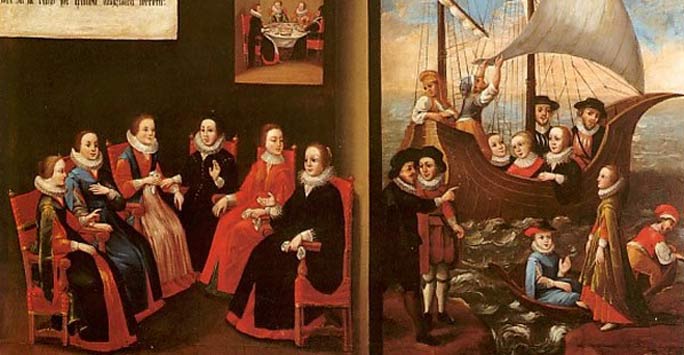Exiled Women – English and Irish nuns at home and away
Posted on: 23 March 2021 by Andrew Foster in 2021 posts

In seventeenth century England, Catholicism was outlawed across the land, punishable by heavy fines, imprisonment, and sometimes execution. Ireland (then under English rule) had just concluded the Nine Year’s War that effectively ended the Gaelic political systems that had survived for centuries, with greater plantation of Protestant settlers to follow.
In short, it was not a good time to be a Catholic in either country. For religious women, they were denied the devotional life that Catholicism offered through the many religious orders and the convents they created, with Protestantism offering no comparable alternative. For these women, their desire for a religious life influenced their voluntary exile in mainland Europe, but setting up new convents in an unfamiliar land was no easy task. My research concerns these women: How they built and developed their communities in exile, what challenges they faced, and what happened when – if they chose to do so – they returned to their homeland.
The earliest of these exile convents, the Benedictine abbey at Brussels, was formed in 1598 to meet the demand for convents specifically for English exiles. Before then these exiles joined existing convents in their host countries, often struggling with the language barrier and with adjusting to a different way of life. Mary Percy and Mary Ward took the initiative to establish their own English convents in exile in Brussels and Gravelines respectively. These early convents attracted many new members over the next twenty years, eventually growing so large that they led to splinter communities including those at Dunkirk, Rouen, and Ghent. Many of these convents were enclosed according to the customs of their order or of Counter-Reformation policy, meaning the nuns had very limited interaction with the outside world. However there were some communities that resisted this expectation, particularly the Institute of Mary, created by Mary Ward. She created a new female religious order dedicated to providing Catholic education across the whole of Europe while offering a religious vocation for women, without enclosure or the wearing of the habit. Such a radically unconventional community angered many of the more conservative Catholic figures, eventually leading to the order’s suppression in 1631, but even this did not stop the order’s expansion and mission to provide education and a religious life to women. It was virtually the only female religious community to return to and operate in England during the seventeenth century.
For Irish Poor Clare nuns in exile, they started their careers at the English convent in Gravelines before leaving to create two convents in Dunkirk and Nieuwpoort. They found little financial success and attracted few members, but by returning the Ireland in 1629 their community grew far more rapidly. After briefly operating in Dublin before being arrested and expelled, they created the Bethlehem convent in Athlone, Co. Westmeath, and experienced an unprecedented ‘golden age’. Catholicism was officially illegal in Ireland, but in practice many Irish people remained Catholic and the anti-Catholic laws were barely enforced outside of the Pale. In Ireland the Irish Poor Clares were able to attract far more women to their convent than in exile, and were also able to engage with the scholarly community to commission Irish translations of their devotional texts. This came to an end as rebellion and war throughout the 1640s forced them to relocate and establish convents elsewhere, eventually leading to most of their members having to return to exile in 1653, but even under such hostile and dangerous conditions they were able to practice their religious life as they saw fit.
For both England and Ireland, the seventeenth century was a period of intense violence, with religious differences being a central component to the various conflicts. It was a period where religious loyalties became synonymous with secular and national loyalties, where any outliers were treated as disloyal or even treasonous. For Catholic women wanting a devotional life outside of marriage, the Poor Clare convents in Ireland and the English convents abroad offered women an option that was denied them under Protestantism. These were communities of women who braved many hardships at home and in exile, but nonetheless pursued their goals and maintained their way of life against all adversity.
Andrew Foster is a PhD student at the Institute of Irish Studies. Learn all about the department here.
Keywords: University of Liverpool, Irish Studies, Nuns, Ireland, Women, PhD, Institute of Irish Studies , Study, Liverpool.